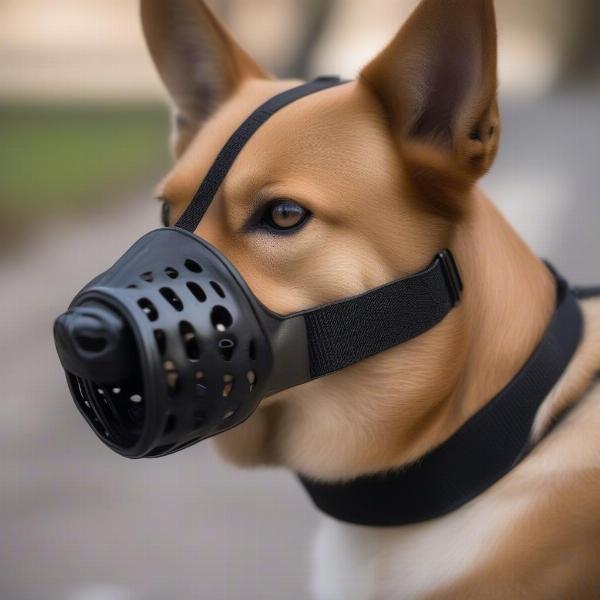Dog muzzles. The very word can evoke strong reactions. While some may see them as a sign of aggression, the truth is far more nuanced. A muzzle can be a valuable tool for many dogs and situations, providing safety and peace of mind for both the dog and those around them. This guide explores everything you need to know about dog muzzles, from choosing the right type to proper usage and addressing common concerns.
Types of Dog Muzzles and Their Uses
Choosing the right muzzle is crucial for your dog’s comfort and safety. There are various types available, each designed for specific purposes:
-
Basket Muzzles: These are the most common type, allowing the dog to pant, drink, and even take treats. They offer good ventilation and are suitable for walks, vet visits, and grooming.
 Dog wearing a basket muzzle
Dog wearing a basket muzzle -
Soft Muzzles: Made from fabric or mesh, these muzzles are lightweight and offer a snug fit. They restrict biting but can make panting difficult, so they’re best for short-term use. mesh muzzle dog
-
Short-Snout Muzzles: Specifically designed for brachycephalic breeds like Bulldogs and Pugs, these muzzles provide breathing room while preventing bites. dog muzzle for bulldog
-
Muzzles for Greyhounds: Greyhounds have unique snout shapes, requiring specially designed muzzles that allow for comfortable panting while racing or during other activities. dog muzzle greyhound
When Should You Use a Dog Muzzle?
Muzzles aren’t just for aggressive dogs. They can be beneficial in various situations:
-
Veterinary Visits: A muzzle can prevent bites if a dog is in pain or stressed during examinations or procedures.
-
Grooming: Some dogs become anxious or defensive during grooming, making a muzzle necessary to protect the groomer.
-
Introducing New Dogs: A muzzle can help manage interactions and prevent bites during initial introductions.
-
Preventing Scavenging: Muzzles can deter dogs from eating potentially harmful items on walks.
-
Public Transportation: Many public transport systems require dogs to wear muzzles.
-
Recovery from Injury or Surgery: A muzzle can prevent a dog from licking or biting at wounds.
Introducing Your Dog to a Muzzle
Introducing a muzzle gradually and positively is crucial for your dog’s acceptance. Start by letting your dog sniff and explore the muzzle. Associate it with positive experiences like treats and praise. Gradually increase the duration of wear, ensuring your dog remains comfortable throughout the process.
Common Myths about Dog Muzzles
One common misconception is that muzzles are only for aggressive dogs. This is simply not true. As detailed above, many situations benefit from muzzle use, even for the friendliest dogs. Another myth is that muzzles prevent dogs from panting. Choosing the correct type, like a basket muzzle, allows for normal panting and drinking. wire dog muzzle
Ensuring a Comfortable and Safe Fit
A properly fitted muzzle is essential. It should be snug but not too tight, allowing the dog to pant and drink comfortably. Regularly check for any signs of rubbing or discomfort. dog muzzle for yorkie
Expert Advice on Muzzle Training
“Positive reinforcement is key to successful muzzle training,” says renowned canine behaviorist, Dr. Sarah Williams. “By associating the muzzle with positive experiences, you can help your dog view it as a normal and comfortable part of their life.”
Another expert, Dr. Emily Carter, adds, “Never force a muzzle onto a dog. Patience and positive reinforcement are essential for building a positive association.”
Conclusion
Dog muzzles are a valuable tool for various situations, offering safety and peace of mind. By understanding the different types of muzzles, their uses, and proper training techniques, you can ensure a positive experience for both you and your dog. Choosing the right muzzle and introducing it correctly can transform it from a symbol of fear to a tool of safety and comfort.
FAQ
-
Do muzzles prevent dogs from panting? No, properly fitted basket muzzles allow for normal panting and drinking.
-
Are muzzles only for aggressive dogs? No, muzzles can be used in various situations, including vet visits, grooming, and introducing new dogs, regardless of temperament.
-
How do I choose the right muzzle size for my dog? Measure your dog’s snout circumference and length to ensure a comfortable and safe fit.
-
Can I leave a muzzle on my dog all day? No, muzzles should not be used for extended periods without supervision.
-
How do I introduce my dog to a muzzle? Start slowly and positively, associating the muzzle with treats and praise.
-
Are there muzzles for short-nosed breeds? Yes, short-snout muzzles are specifically designed for brachycephalic breeds.
-
Where can I purchase a dog muzzle? Dog muzzles are available at pet stores, veterinary clinics, and online retailers.
About ILM Dog
ILM Dog is your trusted source for expert advice on all aspects of dog care and well-being. We offer a comprehensive range of resources, from breed selection and puppy care to senior dog health, training, nutrition, and grooming. Our mission is to empower dog owners worldwide with the knowledge and tools they need to provide the best possible care for their furry companions. For expert advice tailored to your dog’s specific needs, contact us via email at [email protected] or phone at +44 20-3965-8624.